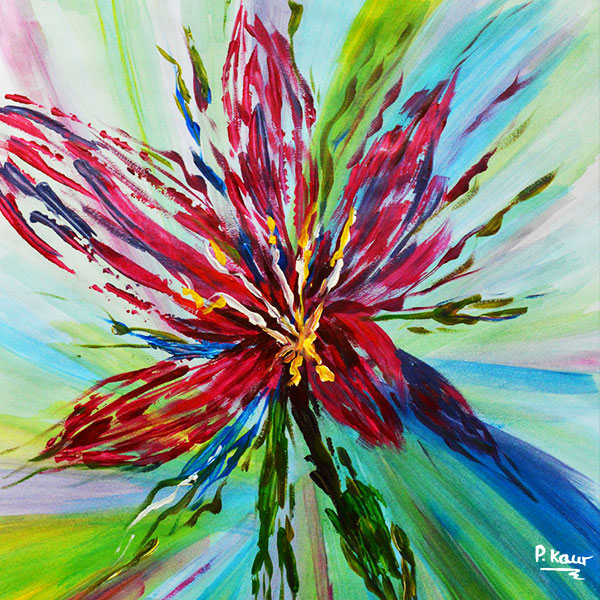Pigments, paints and decoration. Using colours to express ourselves seems to be unique to humans. Other species of the Homo genus may have contributed to cave paintings. The earliest pigment use found has been in caves around 100,000 years ago. Grinding stones have been found with pigments on them.
Early Use of Pigments
Early use of pigments would have meant grinding up naturally found minerals and using a binder and an applicator to create a rudimentary paint. The binders were likely water, blood, saliva, urine, or oil. Applicators would include fingers, leaves and branches. The paint was used for painting the body, perhaps for ritual or decorative purposes.
Paint then was used for the cave paintings. Though due to our inclinations for experimentation, it is possible that painting on walls began outside rather than in the caves. Many of the caves are located in very out of the way and difficult to reach locations. Would we not have experimented on easy to reach walls before venturing into caves? There is evidence to suggest the caves were not inhabited by humans, possibly by other animals but for humans, the cave painting locations were just for that. paint made from these natural sources were susceptible to weathering so evidence wouldn’t have survived to this day if paintings were done on walls outside of caves. Indeed many cave paintings only survive to today because the entrance of the caves were blocked and so the paint wasn’t exposed to the elements.
Later Use of Pigments
As technology increased with the rise of agriculture and civilisation, pigments were used to decorate pottery, decorative objects, homes, buildings, writing, illustration and to dye clothes. Colour became an integral part of identity for many civilisations and their customs. Certain colours were used for certain things.
As we move into the Middle Ages and renaissance times, the use of colour took on new heights. This would be demonstrated in texts, illustrations, canvas paintings, frescos and murals, clothing and fashion, and the political and religious use of colour. Certain colours were only allowed to be worn by certain classes and people, however this soon faded out as we get into modern times. This was also the time of Newton and his discoveries regarding colour and white light.
In the modern age, we find the varied use of colour across digital media and the corporate world. In the digital world, we have access to every colour that is possible thanks to the RGB system. We continue to explore colour on a scientific level, allocating colours for various personalities, seasons and creating colour palettes. Also understanding the role and capabilities of the human eye and the eyes of other animals, how we perceive colour and what it does on a physical and emotional level.
Colours and Pigments
Red
Red is the earliest known pigment used for humanity likely due to its availability in nature. Red was made from red ochre, a common mineral. Another source was cinnabar, a form of mercury sulphide which created vermilion and Chinese red. Ancients also roasted white lead, producing minium. Plant sources of red were madder, the cochineal insect and scale insect.
Orange
Early orange pigments were made from orpiment, realgar and carnelian. Saffron was also used for orange and was for yellow. A synthetic orange colour is chrome orange.
Yellow
Yellow ochre was the first yellow pigment, dating back to cave paintings. Orpiment was another pigment however it’s made from arsenic so was poisonous. Chrome yellow was made from lead-chromium oxide and was poisonous. Other natural sources include saffron, turmeric, jackfruit juice and crystallised urine of cows.
Green
Leaves were the earliest green pigments to be used. Malachite was used and also mixing blue azurite with yellow ochre. Verdigris and green earth are earlier pigments used in ancient times. Scheele’s Green was invented in the late 1700s however was partly made of arsenic and so proved poisonous. Synthetic pigments include cobalt green and green chrome oxide.
Blue
Lapis Lazuli is a deep blue metamorphic rock, first mined in Afghanistan and was used for many years as paint, in jewellery and decorative objects. From this also comes ultramarine. Azurite was another blue mineral used for pigments. Plant based blue pigments include woad, indigo and the dayflower. Synthetic pigments include cobalt blue and versions of ultramarine and indigo.
Purple
The earliest purple tones were made from mixing the minerals manganese and hematite. In ancient times, Tyrian Purple was created, a dye made from sea snails. Other natural sources include the gromwell plant and mursaki root. Purple could also be achieved by mixing red and blue pigments together. Synthetic purples began in late 1700s in the west with colours like cudbear, French purple, Mauveine, cobalt violet and pigments from the quinacridone family.
Pink
There are not many natural pigments of pink. Usually red is used and lightened using white. Some natural pink minerals in pink topaz, pink sapphire and rose quartz. Today, pink pigments are synthetic.
Brown
The earliest pigment comes from umber, a natural earth clay. This was used to create pigments such as burnt umber and burnt sienna. The Ancient Egyptians had mummy brown, made from ground mummies. Other natural sources include walnuts, the chestnut tree, cuttlefish, woad, madder, soil and peat.
White
In ancient times, chalk or calcite were used for white pigments. Pigment made from lead began around 4300 years ago but was poisonous. Modern pigments include titanium white, made from titanium dioxide which is far brighter than the lead pigment and which better coverage. Zinc white and Chinese white are other white colours.
Black
In nature, charcoal is the best source for black pigments. Ancients used soot, which is also carbon based, and used burnt bone and ivory. Later on, black dye could be achieved by mixing various other dyes together. Other natural sources include oak galls, blackberries and walnuts. In modern times, the substance vantablack was created which is the darkest black ever created, for use in science and technology.





